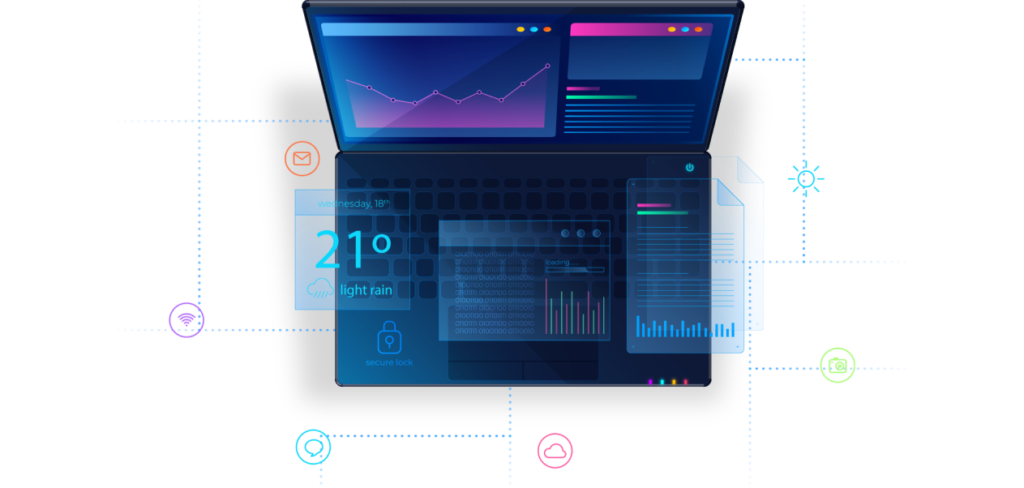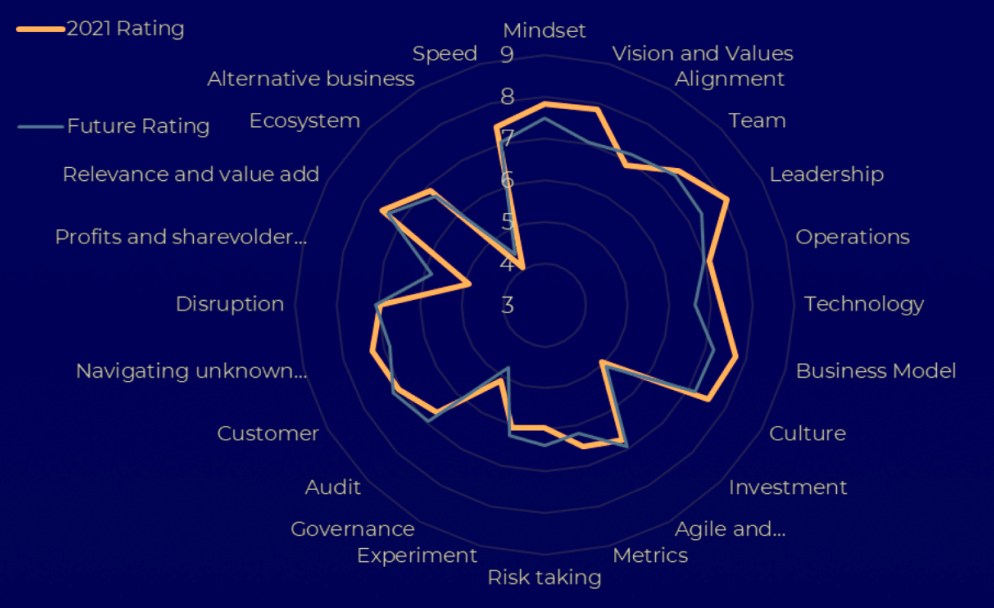Case study
CorpCo

Executive Summary
The CorpCo case study highlights the critical role of foresight and strategic alignment in organizational resilience, particularly during times of leadership transition and market uncertainty. CorpCo, once a thriving organization, faced a period of severe decline marked by public allegations of fraud, mismanagement, and a fractured business strategy. In response, the board appointed a seasoned executive team to stabilize the company, rebuild its reputation, and guide it toward recovery. Despite these efforts, a combination of cultural misalignment, leadership challenges, and strategic inefficiencies continued to hinder progress.
As part of its transition, CorpCo employed WTF (WhatTheForesight) to assess internal perceptions and strategic alignment. The initial deployment of WTF involved surveying a cross-section of employees (N=85) across functions, roles, and demographics. The data revealed alarming trends, most notably that employees believed the organization’s future trajectory would worsen over the next five years. Metrics such as leadership perception, cultural cohesion, and strategic clarity were trending downward, with only minor improvements in vision and values. This underscored a lack of confidence in the leadership team and the effectiveness of the newly implemented strategies.
The WTF analysis also highlighted critical areas requiring immediate attention, including the need for better governance, execution capability, and technology adoption. Profitability and shareholder value showed a modest anticipated improvement, likely reflecting external pressures and marketplace messaging rather than genuine confidence in the company’s strategic direction. These findings provided CorpCo’s leadership with actionable insights, but a lack of follow-through or prioritization resulted in missed opportunities to address the organization’s underlying challenges.
Over the next three years, CorpCo’s financial and operational struggles persisted. Despite efforts to divest non-strategic assets and focus on profitability, the company’s share price and market capitalization declined by 70%, prompting further leadership changes and a renewed call for a turnaround strategy. In hindsight, the insights provided by WTF proved to be accurate predictors of the organizational challenges that later unfolded. Had these insights been acted upon, CorpCo might have mitigated its decline and preserved greater shareholder value.
This case underscores the transformative potential of WTF as a foresight and diagnostic tool. By offering a comprehensive view of organizational health, informed by employee sentiment and strategic indicators, WTF equips companies to address internal misalignment, rebuild confidence, and make data-driven decisions. CorpCo’s experience illustrates the consequences of disregarding such insights and highlights the importance of leveraging foresight to navigate complex transitions effectively.


Client Overview: CorpCo
Like many organizations, CorpCo experienced phases of startup, scale-up, accelerated growth, and maturity before beginning to show signs of decline. In recent years, the company faced serious public allegations of fraud, financial mismanagement, and even bribery. These revelations led to the resignation of the executive team, prompting the board to appoint a seasoned executive with decades of corporate experience and a strong reputation in South African business.
Under new leadership, CorpCo initiated strategic efforts to reverse its downward trajectory, address cultural disillusionment, and stabilize its share price. Historically, CorpCo had pursued a growth-by-acquisition model, acquiring multiple companies without a unified business strategy. This approach led to misalignment, duplicative backend services, internal conflicts, and a fractured brand identity, ultimately causing external confusion about CorpCo’s core purpose and offerings.




Strategic Transition and Early Insights with WTF
Upon engagement, CorpCo was seeking to redefine its future strategy under new executive leadership, following a period of public scrutiny and operational decline. The primary objective was to develop a resilient strategy for CorpCo’s revitalization, which required not only difficult decisions around asset restructuring but also a focus on restoring corporate transparency and governance. As a result, CorpCo began divesting non-strategic assets and, in some cases, evaluating the sale of profitable divisions to refocus on core competencies, elevate profitability, and improve public perception.
WTF (WhatTheForesight) was trialled as a pivotal tool in this early-stage transition to assess internal perceptions and pinpoint strategic obstacles within the company’s culture. Given that the organization was undergoing significant change, WTF offered CorpCo’s leadership a critical window into employee sentiment and alignment with the company’s new direction. To capture a representative sample, the assessment included 85 employees across diverse departments, functions, and age groups. Although conducted during WTF’s PhD based research phase—before its development into the full commercial SaaS tool now available—the insights were nonetheless impactful. The findings illuminated critical organizational challenges, setting the foundation for targeted strategic actions.
Eighteen months after the leadership transition, these initial insights from WTF revealed underlying friction points and areas for improvement that were essential for CorpCo’s turnaround. By identifying the root causes of misalignment and cultural disunity early on, CorpCo’s leadership was better equipped to implement focused interventions, ensuring that restructuring efforts aligned with a sustainable, forward-looking business model – unfortunately they failed to act on these insights.


Initial Findings: Alarming Trends and Perception of Leadership
WTF analysis uncovered critical concerns within CorpCo, revealing urgent issues that the leadership team needed to address. A review of the spider diagram highlighted a particularly troubling trend: future perceptions of CorpCo’s performance were notably lower than current assessments. Represented by the orange line on the diagram, the future outlook showed a regression across key metrics compared to the current state (blue line) where ideally the orange would be closer to the circumference than blue indicating perceived future improvement. This indicated that employees felt CorpCo’s trajectory would worsen over the next five years, signalling a deep-seated lack of confidence in both the existing leadership and the business model. Such perceptions underscored the severity of CorpCo’s cultural and strategic challenges and suggested that urgent, corrective action was necessary to instil renewed confidence in the organization’s direction by the new leadership team.

Among the leadership metrics, only Vision and Values demonstrated positive momentum, albeit negligable. This slight uptick suggested that, while employees acknowledged some effort by the new regime to implement a forward-looking vision, other critical leadership attributes remained problematic. Specifically, the overall perception of leadership—captured in the question, “How do you rate your leadership?”—dropped from a current score of 8.1 to a future score of 7.2. This notable decline reflected widespread doubt in the leadership team’s ability to effectively guide CorpCo toward a successful future away from the current malaise.
Further analysis showed similar downward trends across other crucial dimensions, including technology adoption, business model relevance, corporate culture, and resilience in navigating uncertainties. Collectively, these metrics indicated a pervasive belief among employees that CorpCo’s current approach was inadequate Further analysis showed similar downward trends across other crucial dimensions, including technology adoption, business model relevance, corporate culture, and resilience in navigating uncertainties. Collectively, these metrics indicated a pervasive belief among employees that CorpCo’s current approach was inadequate to meet the evolving demands of the market and the organization’s future was in jeopardy. By highlighting these challenges, WTF’ insights offered the leadership team a data-driven understanding of the critical areas in need of immediate attention, enabling CorpCo to prioritize strategic actions that would address the root causes of employee disillusionment and foster a stronger, future-focused organization as they attempted to turn around the ship heading toward the proverbial iceberg.

Ongoing Concerns and Missed Opportunities for Intervention
The WTF analysis highlighted significant concerns, revealing CorpCo’s current processes and practices were insufficient to address its ongoing challenges. Across most tracked metrics, indicators were trending in the wrong direction, suggesting that existing interventions were failing to put CorpCo on a path to recovery. However, a few areas—such as execution capability, governance, and, most notably, profitability and shareholder value—were expected to show modest improvement over time.
The projected increase in profitability, despite general skepticism about leadership’s effectiveness, likely reflected a widespread acknowledgment of CorpCo’s financial distress and an assumption that improved financial performance was essential for the company’s survival. This sentiment may have been shaped by media coverage and internal messaging that emphasized the leadership team’s focus on financial stability. Although employees seemed unconvinced of leadership’s ability to address deeper organizational issues, external pressure and public communications likely influenced the perception that profitability would increase, at least in the near future.
These findings were shared with CorpCo’s leadership as part of the WTF debrief. However, the insights may not have received the level of attention they warranted, as the executive team faced a multitude of competing priorities and didn’t take heed of the findings presented. Consequently, no formal follow-up actions using WTF’s recommendations were initiated, nor was feedback provided on potential strategic adjustments based on the data. The lack of engagement with these findings represents a missed opportunity for CorpCo’s leadership to leverage perception data as a foundation for targeted, timely interventions during a critical period of organizational change.



Long-Term Outcomes and Reflections
Over the subsequent three years, CorpCo’s performance continued to decline despite the efforts of the new executive team. Media reports frequently covered the CEO’s attempts to implement a turnaround strategy, which primarily involved divesting misaligned assets to focus on profitability. However, these decisions did not yield the desired market response. CorpCo’s share price and market capitalization ultimately fell by approximately 80%, leading to significant shareholder dissatisfaction and public scrutiny. The board, responding to the company’s sustained underperformance, eventually replaced the executive team in a renewed effort to initiate a turnaround.
In retrospect, the insights from the initial WTF analysis appear even more prescient. The early warning signs indicated by WTF—particularly around declining confidence in leadership, misalignment within the organization, and cultural disunity—mirrored the core issues that later plagued CorpCo’s attempted recovery. While some elements may reflect correlation rather than direct causation, the initial findings captured an accurate snapshot of internal challenges that would go on to hinder CorpCo’s success. This case illustrates how perception data, like that gathered through WTF, can serve as an invaluable diagnostic tool months and years before they manifest, helping companies identify and address critical risks before they escalate.

The challenges that contributed to CorpCo’s downfall underscore the importance of leadership effectiveness and cultural cohesion in steering a successful turnaround. Had the insights from WTF been leveraged and acted upon with urgency, CorpCo might have been able to course-correct earlier, preserving both shareholder value and market confidence whilst building a more aligned company. This outcome serves as a powerful reminder of the value of foresight tools like WTF in diagnosing underlying organizational issues and guiding strategic decision-making for sustainable growth and resilience.
Conclusion
The case of CorpCo demonstrates the critical importance of early intervention, strategic alignment, and strong leadership—all areas that WTF is uniquely designed to support. As shown in this case, WTF provided CorpCo with an in-depth, data-driven analysis of its organizational health, uncovering significant perception gaps, leadership weaknesses, and misalignment between short-term actions and long-term goals. Despite these early warning signals, CorpCo’s decision not to leverage the insights from WTF contributed to its prolonged decline, highlighting the cost of disregarding foresight data in favor of reactive measures.
WTF’s capacity to offer a holistic snapshot of an organization’s health, incorporating the views of employees at all levels, is invaluable for identifying potential issues before they escalate. By offering visibility into key metrics like leadership perception, cultural alignment, and strategic readiness, WTF empowers organizations to take proactive steps that build resilience and create a unified path forward. For startups and established companies alike, WTF is not just a diagnostic tool; it’s a compass that can steer an organization towards sustainable success by aligning operational practices with employee sentiment and market expectations.
Key Takeaways from the CorpCo Case Study:
Early Detection of Cultural and Strategic Misalignment:
WTF’s insights into CorpCo’s organisational alignment and leadership perception provided early indications of potential decline, which, if acted upon, could have guided effective interventions.
Data-Driven Decision-Making:
The initial WTF assessment highlighted a disconnect between the leadership’s vision and employee confidence. By ignoring these metrics, CorpCo missed a critical opportunity to regain internal and external trust.
Value of Proactive Foresight in Times of Crisis:
As the case of CorpCo shows, relying solely on reactive strategies may lead to diminished market confidence and financial loss. Foresight tools like WTF allow companies to address issues preemptively and align with evolving market demands.
The Cost of Overlooking Perception Data:
CorpCo’s decline underscores the risks associated with dismissing perception data. Employee and stakeholder views offer invaluable insights that, when properly integrated, can enhance strategy and performance.
WTF is a tool that goes beyond simple analysis, offering organizations a roadmap to navigate complex transitions with clarity and confidence. It ensures that every strategic decision is informed by real-time insights, enabling companies to act quickly, maintain alignment, and drive sustainable growth in an increasingly unpredictable world.